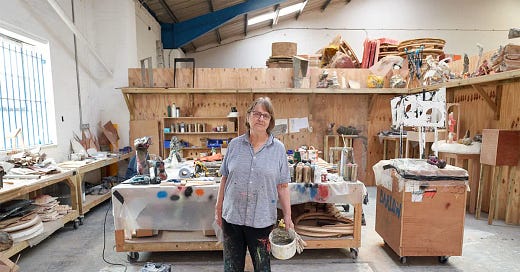Artist Spotlight: Phyllida Barlow (1944–2023)
In loving memory of the artist who made us see and experience art differently
Dear Readers,
Today we honour Phyllida Barlow, one of the most profound artists and sculptors of her generation.
Born in Newcastle, and raised in London, Barlow studied at Chelsea School of Art and completed her MA at The Slade – where she taught for over 40 years (until 2009). My favourite of Barlow’s exhibitions include her takeover at Tate Britain (2014), and her British Pavilion at the Venice Biennale (2017).
Simultaneously colossal and intimate, precarious and triumphant, stoic and ephemeral, Barlow’s all-engulfing sculptures – made from cement, cardboard, fabric, and chicken wire – question the limitless potentials of the versatile medium. She takes influence from her surroundings – and in turn, challenges ours – and her works distort all sense of perspective, challenge sculptural conventions and ideas of modern monuments, and make us experience the medium in ways that no artist had done before.
In 2021, I was lucky enough to interview Barlow for the GWA Podcast. See below for some favourite snippets. Listen to the full episode here.
Love Katy. Xoxo
On art and time, and looking:
"I began to think about how long will anyone actually look at these works, as they're going from A to B? What if I make sculptures that are actually about being walked past than being stood in front of and gazed at for many minutes? What about making work that is intentionally and purposefully about being glimpsed, or just caught? These works are something you walk past – that you would notice almost subconsciously. I became intrigued by something about the demand of art to be something you've got to give time to in a certain way. That's a wonderful aspect of it.
But maybe not all art is about that long look, maybe there is art that's like being on a train journey, where you see things and they absolutely capture you. But you've only had a split second to absorb it – that becomes equally as intense as the thing that you've given a lot of time to looking at. I was fascinated by that notion of the fleeting impact of a work on someone..."
On challenging the traditions of sculpture:
“I'm not afraid of tradition – using things like armatures, using things like cladding, and experimenting with the surface qualities and attempting to bring into the world things that haven't been in the world before… that are not so easy to identify or give a name to, even though they might be born out of observations from the world around us…”
On our relationship to sculpture:
“I think the relationship of a warm blooded creature vs an object that is still and silent – which is essentially what I think sculpture is – for me is the sort of fundamentals. Sculpture is in our everyday lives the whole time. Crossing the road with a lorry coming towards you, is, in my opinion, a sculptural experience, where you as a flesh and blood object is up against the thing that isn't. And one’s emotional and psychological assessment of that all happen in a in a flash.
To me, there is a big, sculptural presence there because of the way that large lorry is constantly displacing space as it comes towards you – so the track that is left behind, which is now empty, was once filled. And that's what I think we do when we're interacting with sculpture: the space is filled. As we walk around it, we are constantly losing an image of it, and finding a new image. So quite a large part of what sculpture is not necessarily visual. And I think that’s quite shocking. A state of affairs that we're assessing.”
On what sculpture requires of us in the 21st century:
“I do think sculpture presents a problem nowadays, in the 21st century. The need to be entertained in art is quite a big issue because whole aspects of the visual arts are about slowing down our ability to look and experience – and that's not always entirely visual. But the emphasis on the visual, and on being entertained, is quite a dominant gene. For a public to become interested in sculpture, it means a very different process of looking: it requires an active process of looking where you, the viewer, have to work a bit, you have to walk around, and take time to see something from several different points of view.
Whereas art that's dealing with some kind of impact enables the viewer to be passive – the art will flood over them, they will be immersed by it. Although on occasions, I use those qualities in the work, I think my touchline is the sculptural aspect of the work: that it is three dimensional, it's occupying a space that you might occupy, it’s responding to the space that's already there, and it's attempting to get the viewer involved in being a protagonist, on equal terms with the space they're in with the object that they're encountering.”
Artist Spotlight is normally part of our new series for paid subscribers, in your inbox every Monday. This Substack is a reader-supported publication. To support The Great Women Artists, sign up here:
If you think someone else might like to read this Substack, please share this article. If you have any feedback, please comment below. Thank you for reading.










Was so sad to hear this news today. Thank you for this lovely tribute. Really enjoyed your podcast with her. Phyllida left a beautiful path of her life. 💖
What lovely work! Bold and gentle at the same time